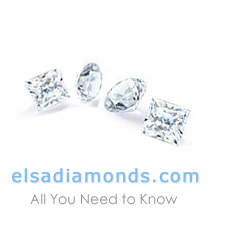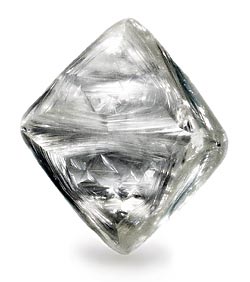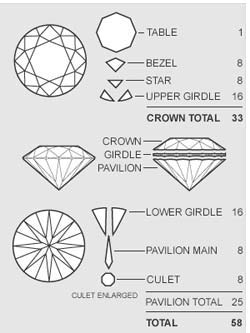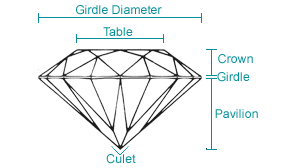
A Diamonds Cut
Diamond Cuts Grade: Why a Diamonds Cut is So Important
It is said that the true worth of a diamond is determined by its clarity, cut, carat and the diamonds color. Generally, people evaluate the worth of their money by a diamond's color and size but they are really naïve about a diamond's cut. In fact, the cut of a diamond is a major factor in establishing its price.
The cut in a diamond is really important as a small mistake in cut can ruin the whole piece so, it should be done intelligently and carefully that enhances the look and beauty of the piece. Therefore, it is totally depends upon the expertise and magic of the diamond cutter's hand in shaping up the raw stone into the refined glittering gem that lays its impact on its wearer for forever.
Diamonds are available in different shapes such as round, oval, marquise, pear, heart, emerald pieces and radiant that distinguishes diamonds according to its varieties. So, it's really tough for a cutter to bring life into a diamond from a dull stone to a dazzling sparkling gem that is forever cherished by its wearer. For making a diamond come alive, certain principles have to be kept in mind. Here they are, in brief:
Diamond Depth
Depth of a diamond is important in giving an accurate angle to the raw piece that further divert the internal lights of the stone from upside, bottom, sides and corners. If it is done poorly, the radiance of the diamond gets lost and restricts its real glow and charm so, the depth is always considered sharply.
Diamond Symmetry
Symmetry refers to perfect alignment of diamond's facets; it satisfies the eye and enhances the brilliance and glow of the diamond. A diamond will look dull and when done improperly and misaligned.
Diamond Polish
Polish means smoothness of the surface of the diamond that brings real glow in the diamond. With the invention of new techniques of polish, it has become very easy to bring out the glitter of the piece and refinement as light easily enters into it and passes easily and effortlessly.
Always Consider the Cut of a Diamond
So, a true diamond is not only based on its clarity, weight and color but its cut is also a major factor in deciding its brilliance and shine that people ignore while diamond shopping. A diamond's brilliance and glow is the reason for its high cost and, it's a fact that the radiance and ultimate vaue of a diamond depends highly on its cut.
 A diamond in its natural state is not spectacular
A diamond in its natural state is not spectacular
Precious stones are cut and polished to develop the beauties which are latent in them. The diamond in a natural state is merely a luminous gray pebble. The diamond does have however, inherent qualities which can be made beautiful. By properly cutting and polishing a diamond, it has the power to reflect and disperse light falling upon it to an extraordinary degree.
Cutting and polishing the diamond will bring out the natural luster or surface power of reflection. The idea is to throw back as much of the light rays as possible. Angled facets are taken advantage of to reflect and refract even more light. Knowing the exact angle to which rays of light are bent on entering, are key to knowing where to place facets to catch fugitive rays that try to pass through the stone by driving them back and forth up the diamonds walls and finally shooting them out and into the beholders eye.

The modern diamond cut consists of fifty eight facets
This arrangement remains the perfect modern cut. During all of the years of improving the refining process, cutting has remained paramount. Cutters will often times sacrifice magnificence in order to have a heavier stone. The royal magnificence of the diamond can be fully attained only by fitting its proportions to the natural qualities of the stone.
It was in America that cutting stones for brilliance rather that weight began. It was popular in Europe to cut more for weight and less for beauty. Beginning with Henry D. Morse, cutting for beauty became a trademark. He would not hesitate to sacrifice material in order to make the finished stone as perfect and beautiful as possible. Machinery to perfect facets was perfected in his shop, and he taught and insisted on mathematical exactitude. Due to demand European cutters have had to confirm to it.
 A Diamonds Dimensions
A Diamonds Dimensions
While a buyer of stones can not always tell by measurements whether or not the stone is cut to its best proportions, he can decide the question by its appearance. An equally proportioned stone shows an equal distribution of light and brilliancy. If the stone is cut too shallow or too deep it will not be as brilliant as a perfectly cut one. The trade has come to find that the proper spread of the stone is of a great importance. A lighter stone that has the same spread diameter as a heavier one may be more brilliant, thus the there is a demand for shallow cut stones. If a stone is just as brilliant at twenty feet as it is at one foot the stones proportions are definitely close.
The first step in diamond cutting is to examine the crystal and decide which way it should be cut to achieve optimal results. Flaws and imperfections in the finished stone should be avoided. Preservation of material, and proportion preserved are both also necessities.
After the cutting of a diamond, next comes polishing
The work is done on a horizontal wheels which make about two thousand revolutions per minute. During the polishing faze, the diamond is kept moist with a mixture of olive oil and diamond-dust. The extent to which stones are polished differ, so like the edges of the facets to be sharp like a knife, while others want them to be less pronounced. If the edges are thin they are less likely to chip, or split.
In todays market it is almost impossible to stock almost any amount of perfectly cut stones. The waste and care necessary to produce them add a considerable amount to the cost. Never the less the public is becoming increasingly more aware of the value of this kind of work. The customer is becoming more willing to pay the difference between a decently cut stone and a fine cut stone. It does take time to truly appreciate a fine cut stone, but the more a person is acquainted, the more confidence he will have with what the dealer has sold him.

 Some time ago you both made a promise. A promise to each other. Now it’s time to recognise that you both meant that promise, and that now you both still mean it.
Some time ago you both made a promise. A promise to each other. Now it’s time to recognise that you both meant that promise, and that now you both still mean it. 